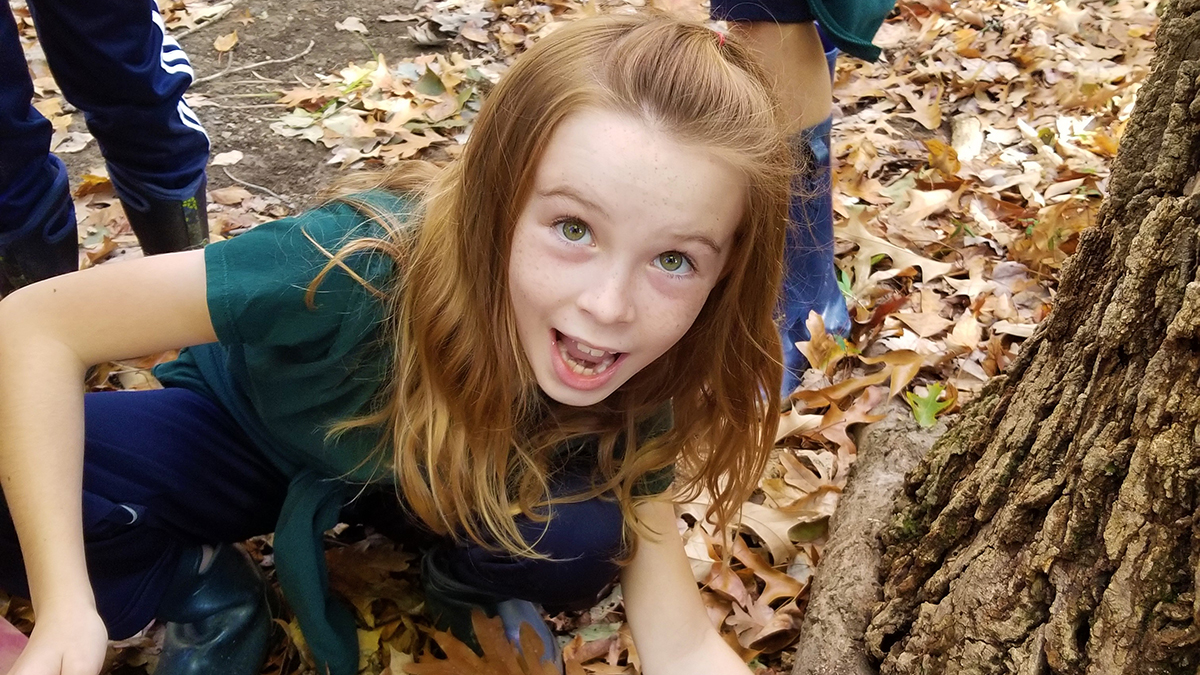Online Exclusive
Wonder-Full Thinking
Promoting inquiry through student-driven investigations
There is something both beautiful and powerful about watching a child’s eyes light up during an investigation, the intensity with which she focuses on an object of interest or the sense of fascination that fuels her explorations. As educators, we recognize that these moments don’t always happen within our structured days at school, and yet we believe strongly that children are capable of “wonder-full” thinking that connects them to the natural world both cognitively and emotionally. This project grew from a desire to sustain children’s interest in scientific inquiry through the investigation of their wonders. The goal was to facilitate children’s wondering as an inquiry process, which ultimately led to the creation of a school-wide Wonder Project. We defined wonder as placing “the human experience at the center of [the] inquiry process,” which involves noticing interesting or unusual phenomena and posing questions from an emotive place of needing to know (Gilbert and Byers 2017, p. 916). Using wonder as a pedagogical tool taps into the uniquely human process that connects our intense need to know with scientific practices such as observing, data gathering, hypothesizing, and so on. This is done by directly connecting an individual’s emotions to science content, which has profound implications for science content learning, including scientific ways of knowing (Sezen-Barrie et al. 2019).
This article highlights an eight-week investigation during which children engaged in varying approaches that documented their wonderings once per week. Students in grades 3–5 rotated through 20-minute stations with various teachers during the weekly structured outdoor time the school implemented to provide curricular connections within a natural environment. We led the students in the wonder inquiry process as a station, yet the engagements and activities could easily be applied within a typical classroom.
Possibilities for Wonder Outdoors
Our efforts were grounded in a belief that children have the ability and interest to generate questions related to their everyday interactions with the world and that utilizing wonder is a powerful means to engage children in inquiry. Wondering allows children to explore their ideas, thinking and hypothesizing beyond the typical worries of getting things perfect, particularly in the early stages of their thinking. As educators looking to inspire children to ask questions, we wanted to provide a forum for children to experience an incubator for ideas, a place where they could use their creativity and interest to begin making sense of the outdoors. Research has demonstrated the numerous benefits of spending time in an outdoor environment (Rickinson et al. 2004) which led us to consider the schoolyard as a place conducive to inspiring wonder as well as promoting all-around well-being in our students.
Although our setting had a significant amount of green space, the Wonder Project could occur in a variety of settings, including an urban environment. School courtyards, landscaped spaces, or even a single tree can all serve as the site for wonderings to take place. Students with unique needs may require additional adult or peer support within the outdoor environment or paved access close to natural settings. There are many excellent resources relating to outdoor learning that contain classroom management strategies, safety and risk assessment tips, and guidelines for effective learning. We suggest acquiring a helpful book geared specifically toward educators teaching in an outdoor environment, such as Outdoor Education: Methods and Strategies (Gilbertson et al. 2006) or Cultivating Outdoor Classrooms: Designing and Implementing Child-Centered Learning Environments (Nelson 2012). Before taking students outside, evaluate your outdoor spaces for common natural hazards, such as poison ivy/thorns as well as potential dangers like broken glass. Many school districts have procedures related to first aid kits and weather protection, so look into these safety regulations before engaging in outdoor learning. Despite the additional challenges inherent with teaching outdoors, we found that the less-bounded nature of an outdoor environment was especially conducive for student wonderings. What follows is a description of the Wonder Project as we engaged children in observation, hypothesizing, and wondering through inquiry.
Launching the Wonder Project
We led a group of upper elementary students into a sparsely wooded area along the school property and directed them to sit in a loose circle. Although the students showed excitement at being out-of-doors, we made it clear that this was a time of learning that differed from recess. We posed the question: What is wonder? The group of students sat quietly as they began to consider the definition of wonder. We extended our wait time until hands began to trickle up.
“It’s about being curious. It’s asking questions.”
“It’s a sense of awe and wow about something.”
Students continued to add on to their classmates’ explanations, and some decided to include examples to help clarify their thinking. Beginning our eight-week Wonder Project with a simple question in an outdoor space successfully initiated student consideration of an abstract idea. After students considered the word itself, wonder, we discussed what types of things people wonder about. A whole-group discussion made it clear that the possibilities were endless. We then told the students we would be spending the next couple of weeks paying attention to the natural phenomena in our outdoor environment—sights, sounds, smells, even textures—and sharing these with our friends. Table 1 shows the various engagements we planned for the students over the course of eight weeks. There was no pressure for the students to stay within these confines, but we noticed that most of our class was eager to engage with wonder.
Table 1. Weekly wondering engagements.
|
Week # |
Teacher-Directed Wondering Engagement |
|
1 |
|
|
2 |
|
|
3 |
|
|
4 |
|
|
5 |
|
|
6 |
|
|
7 |
|
|
8 |
|
Wonder Engagements
Journals
Using materials readily at hand, each student was provided a “wonder journal” that was roughly 15 blank pages held by a plastic binding. We took time to explain what each student could write or draw within the journal. “You’ll be able to write down questions you have about things you notice outside. You can also draw pictures to represent what you see.” We showed the students a few samples from one of our own wonder journals featuring authentic representations of personal wonderings involving squirrels, spider webs, and a rock.
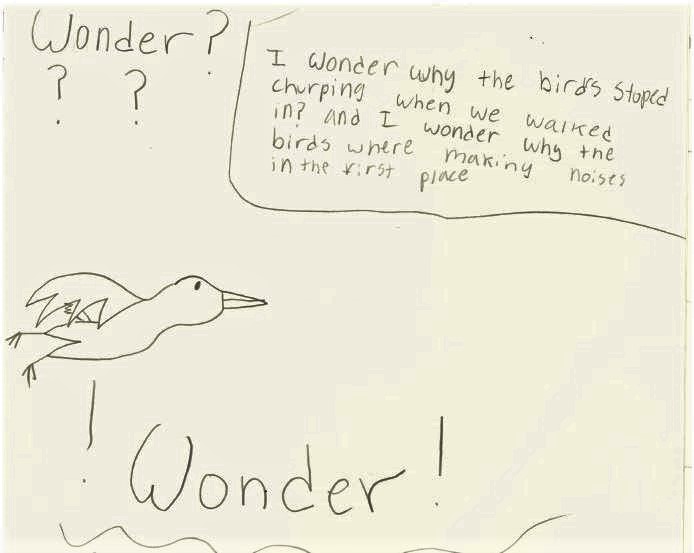
That first day, the students were eager to get started on their wonder journaling, knowing that they would have a lot of freedom regarding their personal journal’s content and that these journals wouldn’t be graded. One student was able to pursue her interest in birds and wrote down questions she had after observing their behavior. Another group of students chose to journal about a mysterious hole in a tree that seemed to lead into a semi-hollow trunk. After gathering back together and sharing journal entries, the students’ facial expressions and exclamations showed excitement when they found out that 20–30 minutes each Monday would be dedicated to outdoor wondering using the journals. We were encouraged by the interest and anticipation that the children were demonstrating.
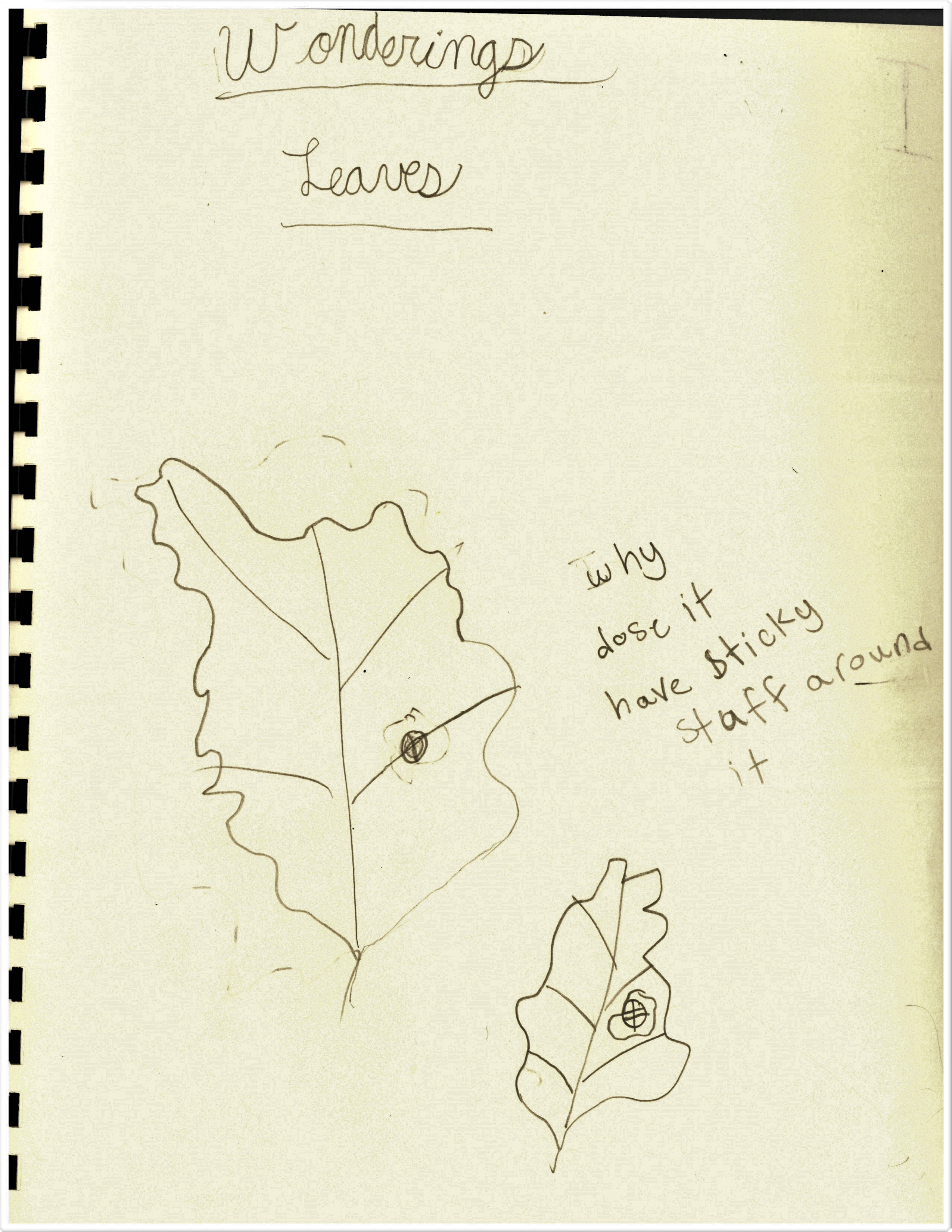
Weekly Wonderings
As teachers, one of our challenges was providing enough structure for our wonder time while also giving the students ample freedom to make their own wonder choices. Some students naturally gravitated toward drawing, with very little words attached to their pictures. Others were more enthusiastic about writing long paragraphs on what they noticed and wondered. We felt that giving students choice was a powerful part of the Wonder Project. Our role as teachers was to encourage, guide, and model a sense of wonder in our own lives. This means that we also scribed for some students who had limited writing ability or offered other writing/drawing tools, such as pens or larger pencils. We felt it was important to create opportunities for students to see the world in a new way and to support students’ discoveries.
One week, we walked along the perimeter of our schoolyard, stopping from time to time for students to write in their wonder journals. Another week, we went belly-down on the field to wonder about a smaller space. Students were given two feet of string as the pathway of their micro-hike (Cornell 1998, p. 50–51). One student chose to place a portion of his string along a small tree stump and became fascinated with the patterns within the wood. He spent a good portion of his wonder journaling time studying the stump’s outlines and considering which types of insects might live in the small holes.
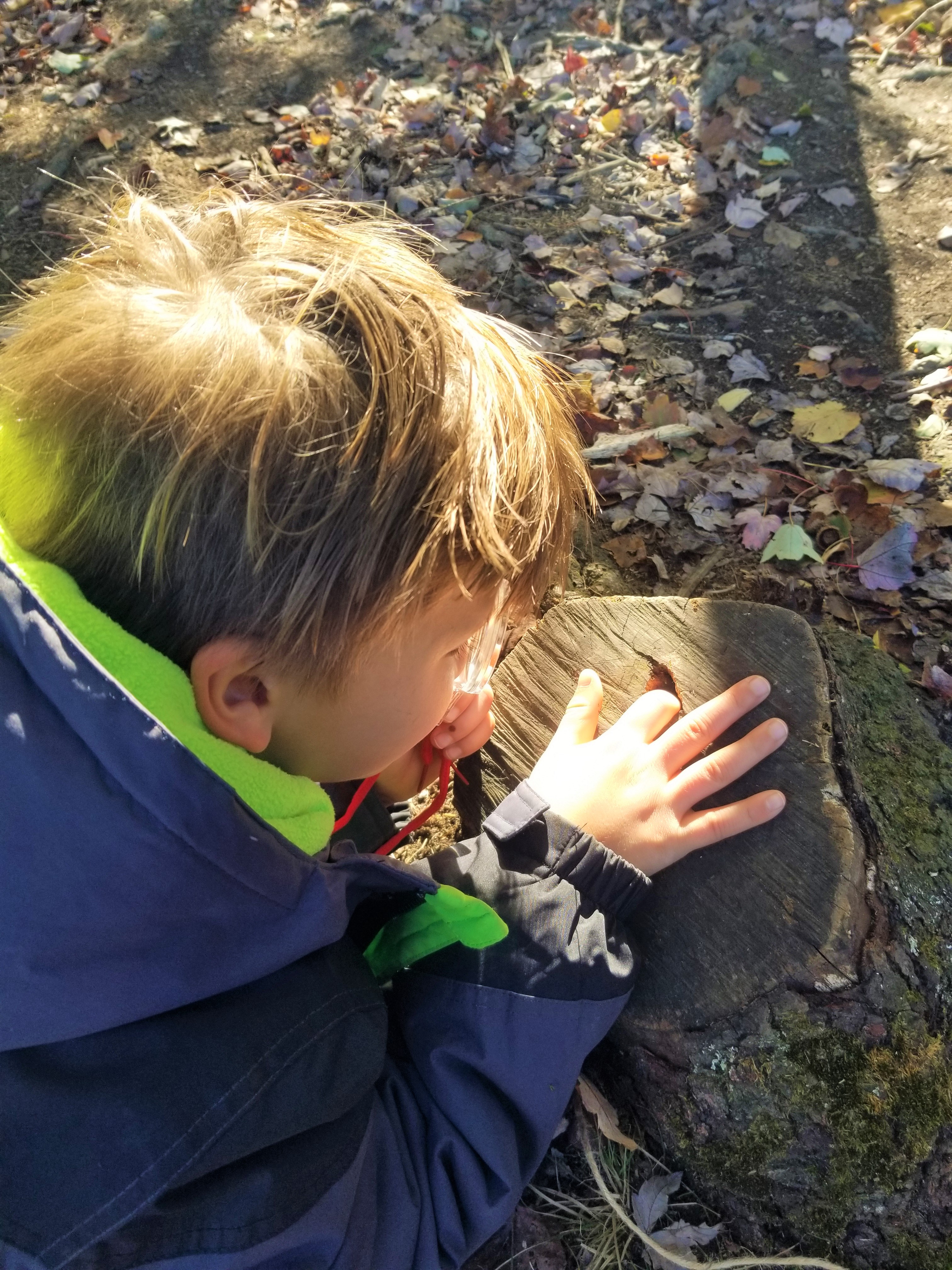
The Power of Observation
The Next Generation Science Standards (NGSS) feature science and engineering practices based on what “professional scientists and engineers do” (NGSS Lead States 2013, p. 2), one of which is asking questions and defining problems. The Wonder Project naturally led students to become close investigators of the natural realm. As teachers, we were fascinated by the focus some of our students had as they saw things in their surroundings that they had never before noticed. For instance, one student made close observations of leaves and then discovered a sticky substance on some of them. This student recorded his close observations in his wonder journal and continued to study foliage throughout the duration of the Wonder Project. During our focus group interviews, students had an opportunity to answer questions about their wonder experiences and many mentioned the power of observation in the wonder process: “But if you go really close, you can see really, really interesting stuff.” (Justin) “I feel like it [the Wonder Project] encouraged students to look around their surroundings.” (Susan)
Being able to make observations and then ask questions is an essential goal of the NGSS, and through structured wonder engagements, students were able to engage in these science practices.
Wonder Fair
After five weeks of wondering and journaling about their wonders, we gathered the students together in the same outdoor space as where we had launched our Wonder Project and challenged students to consider if any of their wonders could be tested. We had a sample poster based on one of our wonderings: How many blades of grass were on our school’s field? Our poster had a prediction and a section on the procedure. We explained to students how we could figure out our wonder question using a square foot, some math calculations, and a calculator. The results section was left blank. The students did not have to necessarily follow through with their wondering, and the reasoning for this was twofold: (1) We didn’t want students to become caught up in choosing a wonder question that could easily be solved in our three-week timeline and (2) We wanted to give them a lot of freedom to think outside of the box. There were general guidelines that we introduced when outlining the Wonder Fair, such as prohibiting internet searching and suggesting that they find a wonder that is testable. This challenged the students to think like scientists. For the remainder of that session (week five) students considered which wonder they could test and contemplated additional wonders.
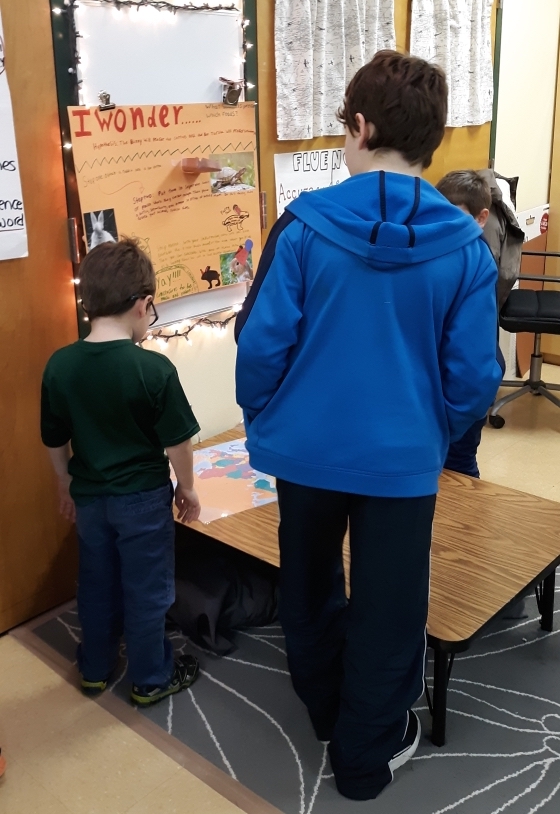
The weeks six and seven were devoted to creating Wonder Fair posters. First, the students worked on a rough draft within their wonder journals. They found a testable wonder and then thought through the investigation process. We gave students the option of whether they wanted to work alone, with a partner, or in a group of three. Students also had options regarding which tools they could use (measuring tape, calculator, etc.), leading some to request specific items from our classroom to bring outside, such as hand lenses. Once students completed their rough draft, they had a check-in meeting with a teacher to show how they hoped to test their wondering. By asking guiding questions, such as What supplies might you need? or How many times do you think you should try [measuring, counting, etc.]? we encouraged students to more fully consider important details. The student who had observed and journaled about sticky substances on leaves a few weeks earlier decided to investigate the best way to remove sap from human skin. He had many ideas about different products that could be used to pursue this line of inquiry (hand soap, dish soap, Vaseline), and was successfully able to describe a step-by-step procedure verbally to a teacher. Another group of students was interested in the variety of leaves on our school property. They wanted to investigate how many kinds of leaves (and trees) were in the playground area. When the group expressed uncertainty on how to procedure, we asked them how they could pursue their wonder using a resource. This prompted one student to remember a tree/leaf identification book she had seen in the library, and the student group successfully wrote out a detailed plan of action. These teacher check-ins were an important part of the Wonder Project and allowed us to connect individually with each student or student group.
After checking in on the rough draft, we provided posters that they could use to display their thinking in a presentable format, which our school was able to supply without the student or teacher procuring additional costs. Large sheets of construction paper, a series of smaller pages, or a trifold could also be used. As students began to work on their good copies, we restated to everyone that the Wonder Fair was about thinking scientifically and considering how certain wonders could possibly be answered. This really seemed to free students up to consider an authentic procedure, even if they didn’t have all the tools or time to complete it.
The whole process was very student-driven. These were their first attempts and served as a starting point for a more traditional science fair that would occur in the spring. There was collaboration, creativity, and some healthy struggle as the students worked on creating a pathway to determine the answer to their wonder. We gave the students time to think about a few talking points related to their poster and to practice spending a few minutes describing their project to a friend. The final posters contained physical attachments, such as rock collections, leaves with egg sacs, and even some plant materials. As a culmination of the Wonder Project, the students set up their posters in the classrooms one afternoon so we could invite younger and older students in the school to stop by and visit. The participating students stayed by their poster while guests wandered the room, stopping to learn more about each project.
We viewed our Wonder Fair as a success due to our own personal observations of students joyfully engaged in scientific discourse within a community setting. There were also many positive remarks from both our students who created the posters and those who visited. One younger student was so inspired that he went home and created his own wonder poster modeled after the ones he saw at our Wonder Fair. This celebration was essential: The students needed to share their wonderings and commemorate their hard work in determining procedures to a potential investigation. When we debriefed together, the overall consensus was that the entire Wonder Fair process was enjoyable and constructive. Many students even mentioned that they intended to turn their Wonder Fair into a science fair project in the spring.
Sample teacher note content
Trenton [Student Name]
10/5 [Date]
- noticed that acorns on the ground looked different from each other
- hypothesized that they came from different types of oak trees
- explained procedure on how to determine which acorns come from which trees when prompted by teacher
10/12
- no written work in the journal entry this week, only a detailed drawing of a log
- “I wonder why this log is rotting and the other one isn’t”
- seems to compare and contrast organisms frequently
Liz [Student Name]
10/5 [Date]
- measured circumference of tree using measuring tape “trying to find out how much bark is on the tree.”
- I asked, “What else would you have to measure?”
- understood the importance of measuring height once I asked if she was measuring bark on one section or the whole trunk
10/12
- needed assistance using a calculator to find area of wrap-around trunk
- successfully understood once I showed her a rolled up piece of paper and encouraged visualizing the problem
Concluding Thoughts and Recommendations
We understand that wonder is a non-traditional approach toward guiding children into inquiry, yet the power of children’s wonders cannot be underestimated. We were impressed at the ability of our students to engage with inquiry and develop procedures for testing their scientific questions that grew directly from the engagement with wondering. Our main goal through the Wonder Project was to connect children emotionally, intuitively, and cognitively to the world that surrounds them as a means to drive their interest in the processes and practices of science. Thus, most of the assessment we did were formative, involving anecdotal notes and one-on-one informal conversations to help students make sense of their thinking. Figure 1 shows a sample of the content within the teachers’ notes. If teachers wish to consider a more summative assessment, they could take into account the wonder journal itself as well as the final Wonder Fair poster and presentation. For example, teachers could have students rewrite one of their wonder journal entries recounting an experience and assess using a rubric featuring specific literacy standards. Teachers could also consider connecting the Wonder Project to a science concept, such as life cycles.
Based on our observations, it was evident that children’s interest in inquiry could be sustained through student-led investigation of wonders. The wonder-filled journal entries and conversations suggested that students thought deeply about the natural world. The Wonder Fair posters indicated that students were able to plan an investigation through their own questions driven from a place of fascination. We believe that other teachers interested in enacting a similar Wonder Project will observe comparable experiences and outcomes in their own students.
Steph Dean (sdean20@gmu.edu) is a PhD student, and Andrew Gilbert is an associate professor, both at George Mason University in Fairfax, Virginia.
References
Cornell, J. 1998. Sharing nature with children. Nevada City, CA: DAWN Publications.
Gilbert, A., and C.C. Byers. 2017. Wonder as a tool to engage preservice elementary teachers in science learning and teaching. Science Education 101 (6): 907–928. https://doi.org/10.1002/sce.21300
Gilbertson, K., T. Bates, T. McLaughlin, and A. Ewert. 2006. Outdoor education: Methods and strategies. Champaign, IL: Human Kinetics.
Nelson, E. 2012. Cultivating outdoor classrooms: Designing and implementing child-centered learning environments. St. Paul, MN: Redleaf Press.
Next Generation Science. (2013). Appendix F: Science and Engineering Practices in the NGSS. https://www.nextgenscience.org/sites/default/files/Appendix%20F%20%20Science%20and%20Engineering%20Practices%20in%20the%20NGSS%20-%20FINAL%20060513.pdf.
Rickinson, M., et al. 2004. A review of research on outdoor learning. Preston Montford, Shropshire: Field Studies Council. https://www.field-studies-council.org/media/268859/2004_a_review_of_research_on_outdoor_learning.pdf
Sezen-Barrie, A., A. Miller-Rushing, and E. Hufnagel. 2019. “It’s a gassy world’: starting with students’ wondering questions to inform climate change education.” Environmental Education Research 25 (6): 1–22. https://doi.org/10.1080/13504622.2019.1610158
Curriculum Inquiry Instructional Materials NGSS Pedagogy Elementary Grade 3 Grade 4 Grade 5



